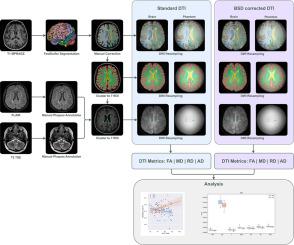当前位置:
X-MOL 学术
›
NeuroImage
›
论文详情
Our official English website, www.x-mol.net, welcomes your feedback! (Note: you will need to create a separate account there.)
Diffusion tensor imaging metrics as natural markers of multiple sclerosis-induced brain disorders with a low Expanded Disability Status Scale score
NeuroImage ( IF 5.7 ) Pub Date : 2024-03-11 , DOI: 10.1016/j.neuroimage.2024.120567 Artur Tadeusz Krzyżak , Julia Lasek , Zofia Schneider , Marcin Wnuk , Amira Bryll , Tadeusz Popiela , Agnieszka Słowik
NeuroImage ( IF 5.7 ) Pub Date : 2024-03-11 , DOI: 10.1016/j.neuroimage.2024.120567 Artur Tadeusz Krzyżak , Julia Lasek , Zofia Schneider , Marcin Wnuk , Amira Bryll , Tadeusz Popiela , Agnieszka Słowik

|
Non-invasive and effective differentiation along with determining the degree of deviations compared to the healthy cohort is important in the case of various brain disorders, including multiple sclerosis (MS). Evaluation of the effectiveness of diffusion tensor metrics (DTM) in 3T DTI for recording MS-related deviations was performed using a time-acceptable MRI protocol with unique comprehensive detection of systematic errors related to spatial heterogeneity of magnetic field gradients. In a clinical study, DTMs were acquired in segmented regions of interest (ROIs) for 50 randomly selected healthy controls (HC) and 50 multiple sclerosis patients. Identical phantom imaging was performed for each clinical measurement to estimate and remove the influence of systematic errors using the b-matrix spatial distribution in the DTI (BSD-DTI) technique. In the absence of statistically significant differences due to age in healthy volunteers and patients with multiple sclerosis, the existence of significant differences between groups was proven using DTM. Moreover, a statistically significant impact of spatial systematic errors occurs for all ROIs and DTMs in the phantom and for approximately 90 % in the HC and MS groups. In the case of a single patient measurement, this appears for all the examined ROIs and DTMs. The obtained DTMs effectively discriminate healthy volunteers from multiple sclerosis patients with a low mean score on the Expanded Disability Status Scale. The magnitude of the group differences is typically significant, with an effect size of approximately 0.5, and similar in both the standard approach and after elimination of systematic errors. Differences were also observed between metrics obtained using these two approaches. Despite a small alterations in mean DTMs values for groups and ROIs (1–3 %), these differences were characterized by a huge effect (effect size ∼0.8 or more). These findings indicate the importance of determining the spatial distribution of systematic errors specific to each MR scanner and DTI acquisition protocol in order to assess their impact on DTM in the ROIs examined. This is crucial to establish accurate DTM values for both individual patients and mean values for a healthy population as a reference. This approach allows for an initial reliable diagnosis based on DTI metrics.
中文翻译:

弥散张量成像指标作为多发性硬化症诱发的脑部疾病的自然标志,扩展残疾状态量表得分较低
对于包括多发性硬化症 (MS) 在内的各种脑部疾病,无创且有效的分化以及确定与健康队列相比的偏差程度非常重要。使用时间可接受的 MRI 协议对 3T DTI 中扩散张量指标 (DTM) 记录 MS 相关偏差的有效性进行了评估,该协议对与磁场梯度空间异质性相关的系统误差进行了独特的全面检测。在一项临床研究中,我们在 50 名随机选择的健康对照 (HC) 和 50 名多发性硬化症患者的分段感兴趣区域 (ROI) 中获取了 DTM。对每次临床测量进行相同的体模成像,以使用 DTI (BSD-DTI) 技术中的 b 矩阵空间分布来估计和消除系统误差的影响。由于健康志愿者和多发性硬化症患者的年龄不存在统计学上的显着差异,因此使用 DTM 证明了组间存在显着差异。此外,空间系统误差对体模中的所有 ROI 和 DTM 以及 HC 和 MS 组中的约 90% 产生了统计上显着的影响。在单个患者测量的情况下,所有检查的 ROI 和 DTM 都会出现此情况。获得的 DTM 可以有效地区分健康志愿者和扩展残疾状态量表平均得分较低的多发性硬化症患者。组间差异的大小通常很显着,效应大小约为 0.5,并且在标准方法和消除系统误差后相似。使用这两种方法获得的指标之间也存在差异。尽管各组和 ROI 的平均 DTM 值略有变化 (1-3%),但这些差异的特点是具有巨大的影响(效应大小约 0.8 或更大)。这些发现表明确定每个 MR 扫描仪和 DTI 采集协议特有的系统误差的空间分布的重要性,以便评估它们对所检查的 ROI 中的 DTM 的影响。这对于为个体患者建立准确的 DTM 值以及作为参考的健康人群的平均值至关重要。这种方法可以根据 DTI 指标进行初步可靠的诊断。
更新日期:2024-03-11
中文翻译:

弥散张量成像指标作为多发性硬化症诱发的脑部疾病的自然标志,扩展残疾状态量表得分较低
对于包括多发性硬化症 (MS) 在内的各种脑部疾病,无创且有效的分化以及确定与健康队列相比的偏差程度非常重要。使用时间可接受的 MRI 协议对 3T DTI 中扩散张量指标 (DTM) 记录 MS 相关偏差的有效性进行了评估,该协议对与磁场梯度空间异质性相关的系统误差进行了独特的全面检测。在一项临床研究中,我们在 50 名随机选择的健康对照 (HC) 和 50 名多发性硬化症患者的分段感兴趣区域 (ROI) 中获取了 DTM。对每次临床测量进行相同的体模成像,以使用 DTI (BSD-DTI) 技术中的 b 矩阵空间分布来估计和消除系统误差的影响。由于健康志愿者和多发性硬化症患者的年龄不存在统计学上的显着差异,因此使用 DTM 证明了组间存在显着差异。此外,空间系统误差对体模中的所有 ROI 和 DTM 以及 HC 和 MS 组中的约 90% 产生了统计上显着的影响。在单个患者测量的情况下,所有检查的 ROI 和 DTM 都会出现此情况。获得的 DTM 可以有效地区分健康志愿者和扩展残疾状态量表平均得分较低的多发性硬化症患者。组间差异的大小通常很显着,效应大小约为 0.5,并且在标准方法和消除系统误差后相似。使用这两种方法获得的指标之间也存在差异。尽管各组和 ROI 的平均 DTM 值略有变化 (1-3%),但这些差异的特点是具有巨大的影响(效应大小约 0.8 或更大)。这些发现表明确定每个 MR 扫描仪和 DTI 采集协议特有的系统误差的空间分布的重要性,以便评估它们对所检查的 ROI 中的 DTM 的影响。这对于为个体患者建立准确的 DTM 值以及作为参考的健康人群的平均值至关重要。这种方法可以根据 DTI 指标进行初步可靠的诊断。



























 京公网安备 11010802027423号
京公网安备 11010802027423号